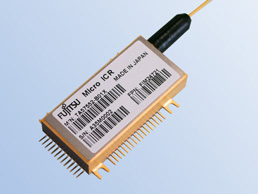Fujitsu Introduces Ultra-compact 100G/200G Integrated Coherent Receiver
Key Features
- Ultra-compact size maintaining same performance and same functions as conventional product
Receivers for digital coherent transmission systems require VOA functionality to variably attenuate the optical power and monitor functions to detect the received optical signal strength. FOC has been successful in drastically reducing the size (1/4 in volume compared to the conventional product) by size reduction design and higher density mounting design for each parts through the use of PLC and micro-assembly technologies while maintaining same performance and same functions as conventional product - 100G DP-QPSK and 200G DP-xQAM modulation support
The design uses miniaturized PLC chips with high optical characteristic along with the integration of many optimally arranged parts to enable support of both 100G DP-QPSK and 200G DP-xQAM modulation. - Support for the interface to the next generation DSP
A digital coherent transmission system achieves high-speed transmission at 100G and beyond 100G by compensating the waveform distortion that occurs in the optical transmission path through digital signal processing. A problem has existed because of the high power consumption required by the current DSP chips to achieve high performance. Reduction of the power consumption for the DSP chip is now proceeding. This integrated coherent receiver supports the electrical signal interface to the next generation low power consumption DSP chips. - Compliant with OIF 2.0 specifications
All specifications (package, optical and electrical specification, electrical pin position etc.) are compliant with OIF 2.0 specifications. This product can be applied to transponders and transceivers designed to be compliant with OIF 2.0.
FOC plans to display samples of this product at OFC 2015, which is scheduled to take place from March 24 to 26 in Los Angeles, California, USA.
Additional Information
- http://www.fujitsu.com/jp/foc/en/
Glossary & Notes
(*1) Acronym for Optical Internetworking Forum. The OIF is an organization that promotes standardization for the equipment and components used in optical network
(*2) Acronym for Dual-Polarization Quadrature Phase Shift Keying. A method of phase modulation for digital signals in which 2 bits of data are allocated to each of 4 modulated optical phases (0, 90, 180, 270°) for both P-polarized and S-polarized light.
(*3) Acronym for Dual Polarization-x Quadrature Amplitude Modulation. A method of phase modulation for digital signals where multiple bits of data are allocated to modulated optical amplitudes and modulated optical phases for both P-polarized and S-polarized light.
(*4) Acronym for Planar Lightwave Circuit. Optical circuit on a silicon chip or quartz substrate containing optical waveguides with accuracies on the order of an optical wavelength
(*5) Acronym for Variable Optical Attenuation function. Function to variably attenuate the optical signal strength. Adjusting the attenuation amount in accordance with the received optical signal strength allows for acceptance of a wide dynamic range of optical input power.
(*6) Function to detect the received optical signal strength. To detect only the received optical signal suppression of the high power local reference light used in heterodyne and intradyne detection systems is required.
(*7) Optical mixer component that is used for coherent signal demodulation purposes in heterodyne and intradyne detection systems. The hybrid mixes the incoming optical data signal with an optical reference source and guides the combined signal to the balanced receivers.
(*8) A receiver consisting of two photodiodes which receive differential optical output from 90° Hybrids. Improved receiver characteristics are achieved by using the difference between the two photodiode currents.
(*9) Converts the received optical signal to an electrical signal in the optical receiving section after combining the received optical signal with a local reference light. The waveform distortion that occurs in the optical transmission path is then compensated for by digital signal processing. This technique allows for significant reduction in system cost through the elimination of optical dispersion compensators and optical amplifiers for loss compensation.
(*10) 1/4 in volume compared to the conventional product compliant with OIF 1.2 type 1
Contacts
Fujitsu Optical Components Limited
Sales & Business Development Division
Sales Promotion Department
![]() E-mail: foc-contact-pr@ml.jp.fujitsu.com
E-mail: foc-contact-pr@ml.jp.fujitsu.com
About Fujitsu Optical Components
Fujitsu Optical Components is a global leading supplier of the most advanced, high performance optical component solutions for high-speed optical networking applications including backbone networks, metro networks and data center. Our product line-up includes 100G Coherent Transceivers, 100G CFP/CFP2/CFP4 Transceivers, 100G/400G LN Modulators, 100G/400G Coherent Receivers, XFP Transceivers and SFP+ Transceivers. For additional information, visit http://www.fujitsu.com/jp/foc/en/.
All other company or product names mentioned herein are trademarks or registered trademarks of their respective owners. Information provided in this press release is accurate at time of publication and is subject to change without advance notice.
日付: 19 March, 2015

